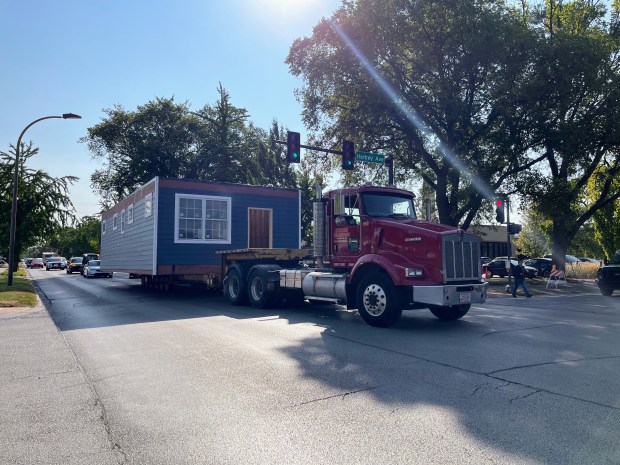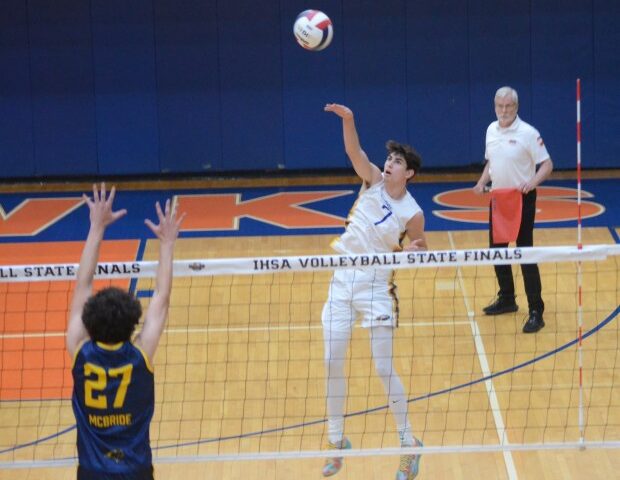Curious neighbors, high school administrators, and city representatives looked on with excitement as they took video and photos of new housing stock that arrived by truck on McDaniel Avenue in Evanston on Monday.
Evanston Township High School, in partnership with the City of Evanston and the nonprofit Community Partners for Affordable Housing, constructed and moved its ninth house, created by 100 students throughout the 2023-2024 school year, to a vacant lot at 1319 McDaniel Avenue. Community Partners for Affordable Housing will sell the home at a price point in line with affordability guidelines.
According to Matthew Kaiser, the instructor for ETHS’ Geometry in Construction, the class that makes the house, ETHS has made buildings to teach students about geometry and construction since 2013. He says the math has all the same content and rigor that any other classroom has. The class often has a waiting list because of its unique experience for its students, he added.
“We contextualize the geometry so that they can see it through the construction of the home. We kind of bring it to life,” Kaiser said.
The high school has made and delivered eight homes in Evanston’s 5th Ward and a two-story athletic storage unit for Evanston Township during the pandemic, Kaiser said. The home on McDaniel Avenue will be the first in the city’s 2nd Ward.
2nd Ward City Councilmember Krissie Harris said the high school’s program of creating affordable housing in the city is “transformative” and benefits everyone involved in the process. “Always having property or something in a vacant spot beautifies and adds to the community,” she said.
“They’re (the students) engaging, and then they are giving to the community,” Harris said. “Let’s say 15 years from now they’re gonna drive by, they’re gonna tell their kids, ‘I built that house in school. I was part of that. I helped build up this community.’”
“And we’re right across from (Dr. Martin Luther King Jr. Literary and Fine Arts School)” Harris said. “I was telling them (high school administrators), hopefully it’s recess time and the kids see this, and say ‘I’ve never seen a house move.’ They maybe have seen a house built, but they’ve never seen a house move. And they’d say ‘How do you do that?’ And then ETHS gets the opportunity to say, ‘Oh, well, you go to ETHS, you can build a house.’ So it’s just generational excitement that builds up.”

Harris and neighbors say that the lot had been vacant for at least five years and previously was the site a single family home, which was torn down. Ever since then, the lot had been used by some to illegally dump garbage, to the ire of neighbors who called the city to remove the waste.
“There was so much junk out there all the time,” said neighbor Sarah Varga. “So we were really happy when the fence got put in, because it kind of like abated the alley so there wasn’t as much (garbage)— although there was still some stuff. But then when we saw the foundation being built, it was like, ‘Oh, they’re actually doing something. That’s awesome.’”
Varga and her neighbor Sarah Ryzcek said they were excited to also learn that the incoming home would be sold at an affordable price, when they were informed of the partnership between the city, high school and nonprofit.
“It’s unbelievable how hard it is to become a homeowner at this point in 2024 — especially if you’re a younger person — it’s hard to even get a foothold. So we need more programs like that,” Ryzcek said.
The nonprofit’s guidelines for someone to buy the home include attending a Community Land Trust Homeownership Program Information Session, which are held monthly on Zoom. A family of four would need to earn less than $134,000 a year to be eligible, or anyone else earning less than 120% of the area median income.
The city’s involvement in the process is to acquire a vacant lot and work with the high school and nonprofit to scope out the land and see if it’s suitable for the project, Harris said. The city then puts the property in a land trust that ensures that even if the owner of the home wishes to sell it, the home will be sold at an affordable rate.
After the nonprofit sells the home to its first owner, Kaiser said the funds earned by the sale are sent to the high school to offset the cost of the material, but the high school typically does not see a profit for them.
“Unfortunately, building prices have been brought up since COVID,” he said. “There’s really no margin for profit on these. We basically get out what we put into them. We’re creating an opportunity for families to afford a home that they probably never could have in other circumstances.”




